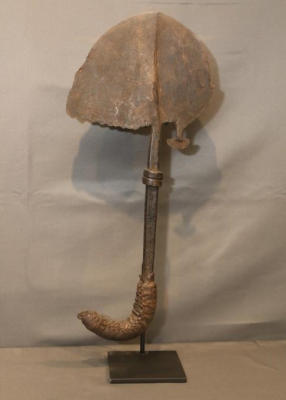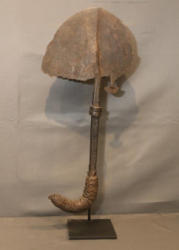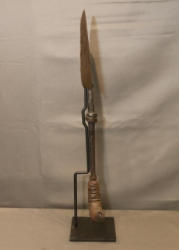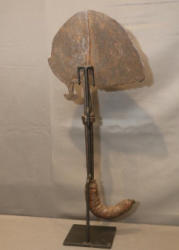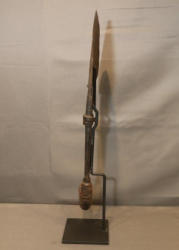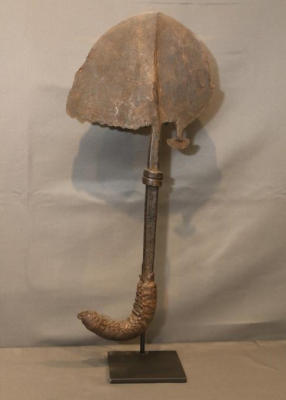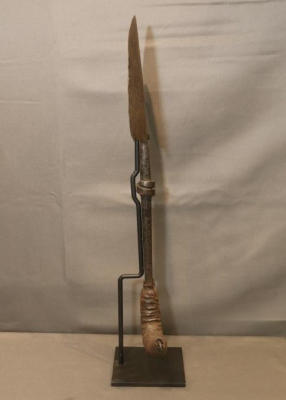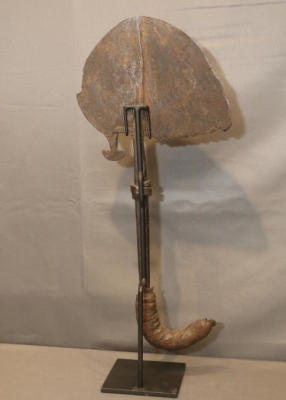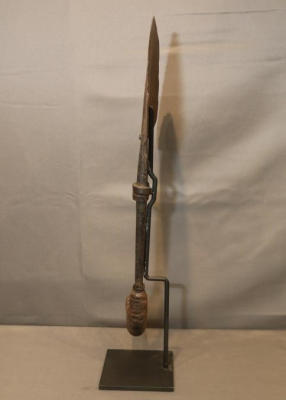Items located in Pleasant Valley, NY. Items include wall plaque from the royal palace, Edo people, Benin; rare masterwork ceremonial ax, Sapo-Sapo/Songye people, Congo; prestige neck ring, Kirdi or Fali people, Nigeria; West African anklet and bracelet bells; late 19thC gold weights, Akan people; and more.
AFRICAN ART COLLECTION OF MARY SUE AND PAUL PETER ROSEN
Mary Sue and Paul Peter Rosen have collected African art for over thirty years, making nine trips to Africa to study the art in its cultural setting. The Rosens have published three African art books, curated more than ten exhibitions from their collection, and have given public lectures about African art and culture. They have donated art from their collection to various institutions including the Newark Museum, Temple University in Philadelphia, the SMA Fathers African Art Museum in Tenafly, New Jersey, and the African American Research Library in Fort Lauderdale, Florida.
Payment is due by Monday, June 3 at 1PM.
Pickup in Pleasant Valley, NY must be completed by Monday, June 3 at 3PM.
All lots sold as is, where is. There is a 15% Buyers Premium for all lots purchased. Payment methods include cash, MC, Visa, Discover or good check. You can make credit card payment online by going to your Member Area and selecting your invoice.
*NOTE* Shipping is available on all items.
AFRICAN ART COLLECTION OF MARY SUE AND PAUL PETER ROSEN
Mary Sue and Paul Peter Rosen have collected African art for over thirty years, making nine trips to Africa to study the art in its cultural setting. The Rosens have published three African art books, curated more than ten exhibitions from their collection, and have given public lectures about African art and culture. They have donated art from their collection to various institutions including the Newark Museum, Temple University in Philadelphia, the SMA Fathers African Art Museum in Tenafly, New Jersey, and the African American Research Library in Fort Lauderdale, Florida.
Payment is due by Monday, June 3 at 1PM.
Pickup in Pleasant Valley, NY must be completed by Monday, June 3 at 3PM.
All lots sold as is, where is. There is a 15% Buyers Premium for all lots purchased. Payment methods include cash, MC, Visa, Discover or good check. You can make credit card payment online by going to your Member Area and selecting your invoice.
*NOTE* Shipping is available on all items.
Auction Info
Items located in Pleasant Valley, NY. Items include wall plaque from the royal palace, Edo people, Benin; rare masterwork ceremonial ax, Sapo-Sapo/Songye people, Congo; prestige neck ring, Kirdi or Fali people, Nigeria; West African anklet and bracelet bells; late 19thC gold weights, Akan people; and more.
AFRICAN ART COLLECTION OF MARY SUE AND PAUL PETER ROSEN
Mary Sue and Paul Peter Rosen have collected African art for over thirty years, making nine trips to Africa to study the art in its cultural setting. The Rosens have published three African art books, curated more than ten exhibitions from their collection, and have given public lectures about African art and culture. They have donated art from their collection to various institutions including the Newark Museum, Temple University in Philadelphia, the SMA Fathers African Art Museum in Tenafly, New Jersey, and the African American Research Library in Fort Lauderdale, Florida.
Payment is due by Monday, June 3 at 1PM.
Pickup in Pleasant Valley, NY must be completed by Monday, June 3 at 3PM.
All lots sold as is, where is. There is a 15% Buyers Premium for all lots purchased. Payment methods include cash, MC, Visa, Discover or good check. You can make credit card payment online by going to your Member Area and selecting your invoice.
*NOTE* Shipping is available on all items.
AFRICAN ART COLLECTION OF MARY SUE AND PAUL PETER ROSEN
Mary Sue and Paul Peter Rosen have collected African art for over thirty years, making nine trips to Africa to study the art in its cultural setting. The Rosens have published three African art books, curated more than ten exhibitions from their collection, and have given public lectures about African art and culture. They have donated art from their collection to various institutions including the Newark Museum, Temple University in Philadelphia, the SMA Fathers African Art Museum in Tenafly, New Jersey, and the African American Research Library in Fort Lauderdale, Florida.
Payment is due by Monday, June 3 at 1PM.
Pickup in Pleasant Valley, NY must be completed by Monday, June 3 at 3PM.
All lots sold as is, where is. There is a 15% Buyers Premium for all lots purchased. Payment methods include cash, MC, Visa, Discover or good check. You can make credit card payment online by going to your Member Area and selecting your invoice.
*NOTE* Shipping is available on all items.
Categories:
JELLYFISH-SHAPED CEREMONIAL HOE CURRENCY (BANDAKA). Mambila and Chamba people, Nigeria and Cameroon. Hoes and hoe blades were an essential part of bride wealth (dowry) payments in many African societies. They were presented to a prospective bride?s family to signal a man?s wish to marry their daughter and his ability to support her. The term, bandaka, derives from the name of the small village (Bandaka) where these objects were observed in use. The blade has two asymmetric sections, slightly offset from each other (not in the same plane) which are separated by a spine that arises from the handle. On one side, the lower edge of the blade is serrated, and an anchor-shaped appendage (sometimes referred to as a ?nose?) hangs from the lower edge on the other side. A carrying cord was stretched from the ?nose? to a ring at the end of the U-shaped handle. The handle is tightly wrapped with sewn leather. An iron band is wrapped around the upper third of the shaft. On custom base. Hand forged iron, leather. H19in.
More Details
JELLYFISH-SHAPED CEREMONIAL HOE CURRENCY (BANDAKA). Mambila and Chamba people, Nigeria and Cameroon. Hoes and hoe blades were an essential part of bride wealth (dowry) payments in many African societies. They were presented to a prospective bride?s family to signal a man?s wish to marry their daughter and his ability to support her. The term, bandaka, derives from the name of the small village (Bandaka) where these objects were observed in use. The blade has two asymmetric sections, slightly offset from each other (not in the same plane) which are separated by a spine that arises from the handle. On one side, the lower edge of the blade is serrated, and an anchor-shaped appendage (sometimes referred to as a ?nose?) hangs from the lower edge on the other side. A carrying cord was stretched from the ?nose? to a ring at the end of the U-shaped handle. The handle is tightly wrapped with sewn leather. An iron band is wrapped around the upper third of the shaft. On custom base. Hand forged iron, leather. H19in.
High Bid:
$200.00 – hera
Auction Type: One Lot
Quantity: 1
Bidding has closed on this lot

